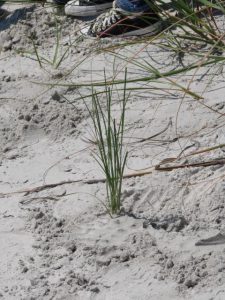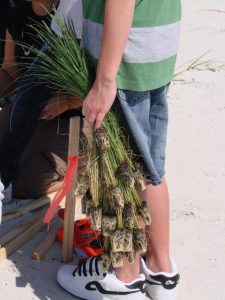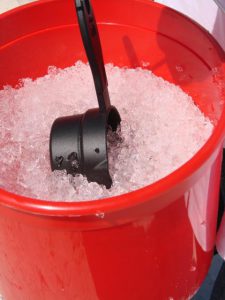
Many beachfront homeowners and municipalities are in the process of restoring dunes that were heavily damaged by Hurricanes Matthew and Irma. This process is regulated and permitted by Florida’s Department of Environmental Protection. Once sand has been placed, it is important to stabilize that sand by planting dune plants. Sea oats (Uniola paniculata) play a major role in stabilizing and building dunes. Sea oats are protected by law. Plants may not be collected and transplanted; rather, seedlings must be obtained from licensed growers. It takes about 64 seedlings to plant an area of dune that is 10’ x 10’ in area. Best planting times in north Florida are between April and October. Much of this time coincides with sea turtle nesting season. Precautions may need to be taken so as not to disturb these nests. Planting sea oats (or any dune plants) is labor- and time-intensive!
Below are some guidelines for planting sea oats. Once established, sea oats plants will spread vegetatively as well as by producing seed. The “liners” that are typically planted are relatively vulnerable during their first few months. To maximize success of the planted seedlings, people should not walk over the young plants!
Some tips for planting sea oats

- Obtain sea oats plants that come from seed from your part of the state (if possible). Gulf coast and east coast sea oats are genetically different. They may not survive as well if planted on the “wrong” coast.
- Several growers in Florida can supply sea oats, but many will not sell to individual homeowners (they only sell wholesale). Most are in the southwest part of the state, or in the panhandle.
- Sea oats are typically sold as liners/plugs, although 4” and larger pots may be available.
- Sea oats need to be planted so that at least 4-6” of the vegetation is buried in sand. This requires creating a hole that is about 8-12 inches deep (but it does not need to be very large in diameter). Because sand blows around so much, if the plants are not planted deep enough, their roots may become exposed and they will not survive.

Hydrated water-absorbing polymer ready to be added to the hole for the sea oats plant. - Sea oats require watering once or twice a week during their first few months. One way to accomplish this is to add about a cup of water absorbing polymer (hydrated) to each hole before adding the plant. The plant will be able to draw water from this gel. Rainfall will re-hydrate the gel so it will continue to keep the plant watered for some time.
- Most recommendations are to sprinkle one teaspoon of time-release fertilizer around the base of each plant. Work the fertilizer into the sand with the spoon or your fingers.
- Individual sea oats should be planted 18” apart, with rows of plants staggered. It is best to start at the top of the dunes and work your way down to the base of the dune.
Click here to read a document explaining how to use straw to help fertilize sea oats that have been planted to restore dunes.
 7
7


Comments:
June 18, 2021
Thank you for your feedback, Frank. Here are a couple of links to our EDIS documents on beneficial insects. The following links include more of the commonly seen beneficial insects: https://edis.ifas.ufl.edu/topic_beneficial_insects and https://mrec.ifas.ufl.edu/lso/BANKER%20IST/Beneficial%20Insects%202.pdf that you can cut and paste into your browser. Though not an exhaustive compilation, they are a good start for identifying beneficial insects in your garden. Have a great day!
June 18, 2021
Many thanks, that information is a real eye opener and I'm sure there are more beneficial insects out there. Do you have a reference guide, thanks, Frank..
December 8, 2020
Hello! Participants must be a member of 4-H or FFA to show in the fair.
December 7, 2020
Do you have to be a member of 4H to enter chickens in the fair? My granddaughter raises hens and would like to participate
November 19, 2020
Hi Lauren, I've checked with some of our plant restoration experts and they say there probably isn't anything that you can do to improve the chances of recovery, but that the plants are surprisingly resilient, so hopefully most will do just fine given a little time...
November 17, 2020
I am a homeowner in Pinellas County. We lost about 40% of our summer planting during Tropical Storm Eta. Is there anything you recommend we do for the remaining plants to help them recover, or is best to leave them alone, and let Mother Nature take care of it?
November 7, 2020
Leroy was a household name in global aquaculture in the 1980s and 90s, serving as President of the World Aquaculture Society in 1994 when I was a graduate student in Germany and in the UK. Someone who knew so much and gave so much his whole life. Rest in Peace, Leroy!
November 7, 2020
LeRoy joined our St. Lucie Extension office in the year 2000 and was an instant fit with our crew. He amazed us with all the projects he was involved in already and then he added more. He made sure we all got some of the farm raised shrimp from the IRREC project next door! He always spoke so proudly of his wife and daughters. He will be missed.
November 7, 2020
LeRpy was a colleague but even more importantly, a very close friend. I find myself constantly thinking that I need to call him to talk about something that just happened. He has left a hole in my heart that will be there forever. Sleep well, amigo.
August 10, 2020
I'm afraid we are not able to help you find buyers for the saw palmetto berries.
August 8, 2020
Who do i sale these berries to
July 13, 2020
Hello, Marilyn. Yes, we do! Please go onto our website at flagler.ifas.ufl.edu and look for the updated blog posting about our Thursday Plant Clinic. There is a zoom registration link at the top of the announcement just below the title. Just click on that live link and a Meeting ID and password will be sent to you. This is the same ID and password for the whole month of July. We look forward to seeing there and please pass the word on to other friends or neighbors that would like to attend our virtual plant clinic.
June 29, 2020
do you have a zoom class for July?
June 23, 2020
Sorry, I do not know of any opportunities for obtaining free sea oats or other dune plants...
June 23, 2020
does the state provide free plants
February 3, 2020
Hi Gerry, I am going to forward your question about funding to my colleague Erik Lovestrand in the UF/IFAS Extension Franklin County Office (elovestrand@ufl.edu) as he may be more aware of support that might be available in your area. The manual "Dune Restoration and Enhancement for the Florida Panhandle" might also be of interest--you can find it at https://edis.ifas.ufl.edu/pdffiles/SG/SG15600.pdf. It recommends planting sea oats between December and April, with preferred dates being in March and April. Maia McGuire
February 2, 2020
We are also trying to restore the dunes and sea oats on a section of Carrabelle Beach on the Gulf Coast near Apalachicola after Hurricane Michael leveled the dunes and the sea oats. Are you aware of any local, state or federal programs to help on the purchase of the sea oats. We have already done a lot of work on the first steps to reestablish the sand dunes. Also, what is the best time to plant? THANKS for any suggestions you might have.
September 21, 2019
Hi Jack, sorry for the delay in responding--we are in the process of hiring a new horticulture agent. I am not sure why the link did not work for you--it is correct. Flagler County is considered to be outside the growing area for mangoes, although that could change as temperatures warm. Currently the northern limit for growing is Merritt Island (Brevard County). See https://edis.ifas.ufl.edu/pdffiles/MG/MG21600.pdf for more information.
August 10, 2019
Link for growing peach trees doesn't work. Also, how do you grow mangoes ? This is for Flagler county - central Fl. Jackkimball126@gmail.com (757) 693-1207 Thank you, Jack Kimball
July 30, 2019
Great to hear that!
July 30, 2019
Thank you for this article. St George Island here. I followed your suggestions, including the use of hydrating polymer (despite having been discouraged from using this material by others). Planted 1200 liners over about 1 month. Last plantings dome about 6-8 weeks ago. 97-98% survival rate with great majority thriving!
July 7, 2019
Your article here is the helpful I've found anywhere. Thank you.
April 8, 2019
The answer somewhat depends on the quantities you will be needing--there are a few wholesalers listed on the Florida Association of Native Nurseries' website. However, they only sell wholesale. If you are looking for a retail outlet, there are a few retailers listed here. You may also be able to work with a local nursery and have them purchase from a wholesaler and then re-sell them. The sources listed on the websites may not be the only ones (the websites only list members of the Association of Native Nurseries), but they are a good starting point. I hope this helps!
April 8, 2019
Pages 77-78 of the publication, Dune Restoration and Enhancement for the Florida Panhandle, might be helpful!
April 8, 2019
Any advice on propagation from local seeds to replenish hurricane depleted dunes ?
April 7, 2019
I am looking to purchase sea oatsplants for doing restoration in Gulf County, Fl. affected by hurricane Michael if you know of any suggestions where I could purchase these, thanks
March 7, 2019
Hi...Thanks for the heads up...I'll pass that on to our website team...
March 7, 2019
Hello there, I do think your site could possibly be having internet browser compatibility issues. Whenever I liok at your web site in Safari, itt lookjs fine but when opening in Intfernet Explorer, it's ggot some overlapping issues. I merely wanted to give you a quick head up! Besides that, wonderful website!
January 7, 2019
Hi Janet--you might want to check out some of the activities on the K-12 page at www.plasticaware.org. Unfortunately there is no simple answer, and there is always the risk of making the problem seem so big that people may feel hopeless to do anything. I think it's best to focus on small acts--if every student in the class did not use one straw a week, for example. In a year, each student would have prevented 52 plastic straws from being thrown away. For a class of 20 students, that's 1,040 straws! This may help them realize that one person can make a difference, and if they can get others to take simple actions, their efforts will be multiplied greatly! Feel free to contact me directly at mpmcg@ufl.edu.
January 7, 2019
I'm an elementary art teacher in central Pennsylvania and would love some hints, tips or classes on how to reach our kids about the need to act. I talk about it and we recycle and make art using recycled objects - I just feel that I could use some ideas. Thank you, Janet
October 6, 2018
Hi Jack. That's a great question. The thought seems to be that the population of pteropods increases based on food availability. Winds and currents can affect where the pteropods are located and whether (and when) the shells will get washed up on beaches. It isn't an uncommon occurrence in Florida (considering the state as a whole), but often occurs over a relatively small stretch of beaches at a time. The shells can wash back into the ocean with subsequent tides, so they may only be apparent on a particular beach for a few days.
October 5, 2018
Great explanation, but why are there so many on the beach...I've never seen them before...what happened or what is happening?
September 7, 2018
Whether or not you need a permit (in Florida, the permits come from the Department of Environmental Protection) depends on the size of the area to be planted, whether or not a sprinkler/irrigation system will be installed, etc. You may be required to coordinate with the local sea turtle patrol if planting will be done during sea turtle nesting season (to ensure no damage is done to nests that may be in or near the area to be planted. You can find your local DEP contact at https://floridadep.gov/water/coastal-construction-control-line/content/district-field-representatives-contact-list. That person will be able to advise you as to whether or not you need a permit (and if so, how to go about obtaining one).
September 6, 2018
Do you have to have a permit to plant sea oats?
August 7, 2018
Hi Nancy, There is one retailer near you listed with the Florida Association of Native Nurseries (www.afnn.org). 7 Pines Native Plant Nursery is in Defuniak Springs, and it sells sea oats in gallon pots, according to the website. There may be other retailers who carry sea oats but are not members of that association. Hope t his helps!
August 5, 2018
I live in okaloosa county and would like to get some sea oat plants...where would that be possible?
February 9, 2018
It is worth the trip! Be sure to get there early - it fills up fast and you'll see lots of other wildlife in the morning :)
February 7, 2018
I am glad you found it useful :)
February 6, 2018
Maia, Thank you so much for this valuable information.
February 2, 2018
Wow! I’m packing my bag for a visit. I had no idea you would be able to see so many manatee in such a short distance. It’s also so exciting to hear about our youth being able to see these creatures in person. Certainly this experience will be a meaniful memory. Thank you for the post!
February 2, 2018
Thanks for your question, Cindy. We have added a link at the bottom of the post to a website that has some images. Hope that helps!
January 31, 2018
Thank you very much for all this information. Can you provide pictures of what you describe of on the infected trees?
Comments are closed.